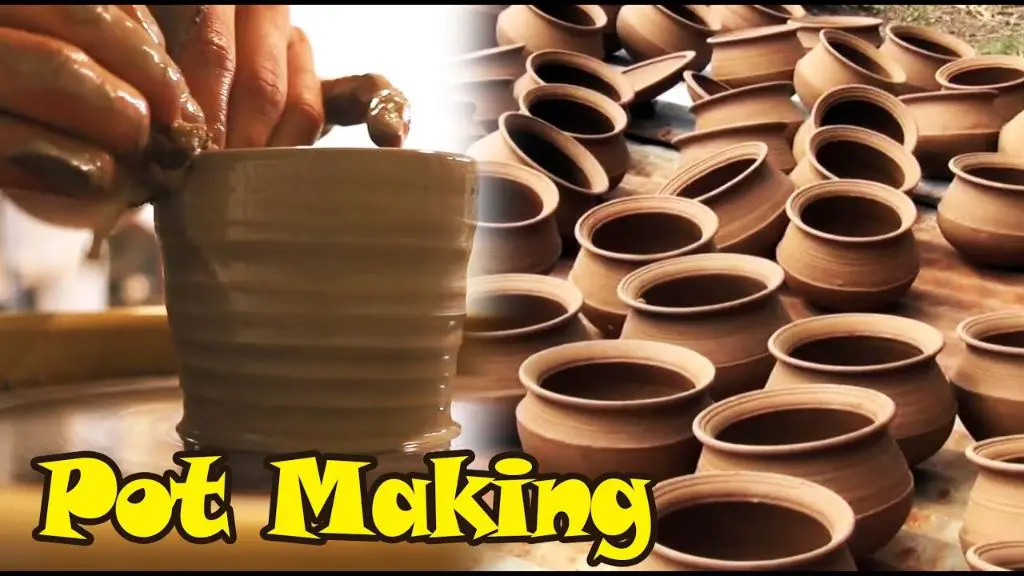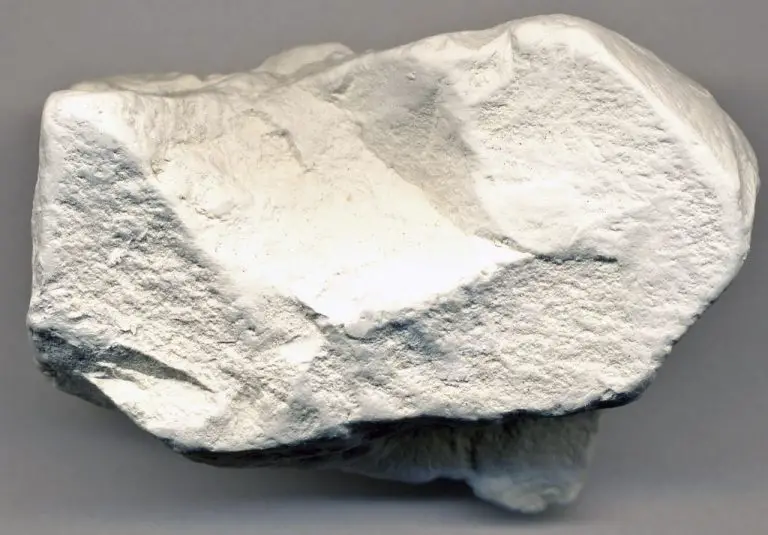Is Clay A Rock Or Dirt?
What is clay?
Clay is a fine-grained natural material composed primarily of hydrated aluminum silicates, usually containing impurities such as potassium, sodium, calcium, magnesium, or iron, and possibly organic matter (Wikipedia, 2022). The size of the particles in clay is less than 4 micrometers in diameter, which makes it feel smooth and plastic (Science Learn, 2010).
The official definition of clay, according to geologists, is a naturally occurring material composed primarily of fine-grained minerals that show plasticity through a variable range of water content, and will harden when dried or fired (Wikipedia, 2022). Plasticity refers to the ability for clay to be molded or shaped.
Clay minerals form over long periods as a result of the gradual chemical weathering of rocks, usually silicate-bearing rocks like granite or basalt. The weathering process breaks down the rocks into finer and finer particles through physical and chemical processes (Science Learn, 2010).
Clay Composition
Clays are composed primarily of fine-grained minerals that generally fall into the chemical groups known as silicates, aluminosilicates, and phyllosilicates. The main elements that make up the composition of clay are:
- Silicon – Silica provides hardness and durability to clays. It is a main ingredient in many clay minerals.
- Aluminum – Alumina provides plasticity and malleability to clays. It is a major constituent of kaolinite, which is the most abundant clay mineral.
- Water – Water is contained in the structure of clay minerals and affects their plasticity. Loss of water can cause clays to become brittle and shrink.
- Iron – Iron ions may substitute for aluminum in the crystalline structure of some clays, giving them distinctive colors ranging from red to brown.
- Magnesium – Magnesium ions may replace aluminum ions in the tetrahedral sheets of some clay minerals such as montmorillonite.
The varying proportions of these elemental ingredients influence the specific properties and behaviors of different clay types. But in general, the abundance of silicon, aluminum, and water defines the fundamental character of clays.
How is clay formed?
Clay forms from the chemical weathering of rocks over long periods of time. The primary chemical process that converts rocks into clay minerals is known as hydrolysis. During hydrolysis, silicate minerals react with water, carbon dioxide, and organic acids, breaking down the original minerals into new phyllosilicate clay minerals.
This weathering process usually takes place over thousands or millions of years in areas with warm, wet climates. Water helps transport weathering agents through rock and soil, speeding up chemical reactions. As rocks weather, elements like potassium, calcium, and magnesium are leached away, leaving behind a clay-rich material.
The most common clay minerals formed through this process include kaolinite, montmorillonite-smectite, illite, and chlorite. Different types of source rocks and variable weathering conditions lead to different clay minerals being formed (Clay. (2022). In Wikipedia). Overall, the slow chemical weathering of rocks by water is the primary natural process behind clay formation.
Types of clay
There are four main types of clay used in pottery and ceramics: kaolin, stoneware, ball clay, and earthenware clay. Clay is categorized based on its chemical composition, mineral content, and firing temperatures.
Kaolin clay, also known as China clay, is a white clay composed primarily of kaolinite. It fires to a white or near-white color at high temperatures. Some key properties of kaolin clay are its fine particle size, high plasticity, and low impurities. Kaolin is commonly used for porcelain and whiteware ceramics (Soulceramics).
Stoneware clay contains varying amounts of feldspar, mica, and other minerals. It fires to a gray, brown, buff, or tan color depending on the mineral content. Stoneware clay can withstand high temperatures around 1200°C-1300°C, resulting in non-porous, vitrified wares. Stoneware has medium plasticity and can be used for functional pottery and art ware (Wheelandclay).
Ball clay, also called plastic clay, consists primarily of the clay mineral kaolinite with some illite and montmorillonite. Its fine particle size, high plasticity, bonding strength, and light firing color make it an important ingredient in porcelain and other ceramic bodies requiring high plasticity (Soulceramics).
Earthenware clays like terracotta contain iron and other impurities that result in red, brown, and buff firing colors at lower temperatures up to approximately 1000°C. Earthenware tends to be highly porous unless glazed. Its lower plasticity makes shaping and handling more difficult than other ceramic clays (Wheelandclay).
Clay Properties
Clay has several distinctive properties that set it apart from other types of soils and rocks. Some key properties of clay include:
Plasticity – Clay is highly plastic and can be molded into different shapes when wet. It becomes very hard when dried or fired.
Cohesiveness – The particles in clay have high cohesion and tend to stick together even when wet. This makes clay sticky and able to hold its shape.

Absorption – Clay can absorb large amounts of water, up to several times its dry mass. The absorption is due to the tiny size of clay particles and their electronegative surface charges.
Drying and Shrinking – As clay loses moisture, it shrinks and cracks. The shrinkage can be as much as 10% or more.
General Impermeability – While clay can absorb large amounts of water, it is generally impermeable to water once fully saturated. This is due to the tight packing of the fine clay particles.
Plasticity allows clay to be shaped into pottery, bricks, pipes, and other objects. Cohesiveness, absorption, and impermeability make clay useful for holding water in ponds and lining canals. The drying and shrinking process is important in manufacture of ceramics. Thus, the unique properties of clay make it useful for many applications.
Uses of clay
Clay is an incredibly versatile material that has been used for thousands of years. Here are some of the main uses of clay:
- Pottery – Clay is the main material used for making pottery, including tableware, art pottery, and ceramic figurines. Clay’s plasticity when wet and hardening when fired make it ideal for shaping and baking into durable pottery pieces.[1]
- Bricks – Clay bricks have been used as building materials for millennia. Modern clay bricks are formed from clay that is wetted, molded, and fired in a kiln. Clay bricks are still popular for their durability, thermal properties, and aesthetic qualities.[2]
- Ceramics – Porcelain, bone china, terra cotta, and stoneware are all types of ceramics made from clay and used to create tableware, tiles, decorative objects, and construction materials.
- Paper – Clay is used in paper production and is added to the paper pulp mixture before screen molding.
- Cement – Clay is one of the four essential ingredients in Portland cement (along with lime, silica sand, and iron ore). The aluminum silicates in clay produce the cementitious properties.
Is clay a rock?
While clay shares some similarities with rocks, it lacks key defining properties that would classify it as an actual rock. Rocks are made up of one or more minerals, with no organic matter. They also have visible crystalline structures and maintain their solid shape without support. In contrast, clay contains both mineral and organic matter, has an extremely small particle size, and lacks an identifiable crystalline structure. When unsupported, clay easily shifts into a plastic state unlike true rocks. While clays are an important component of many sedimentary rocks, on their own they are considered a soil type rather than a proper rock.
Clay’s composition sets it apart from rocks. Most rocks are composed almost entirely of inorganic crystalline minerals, while clay contains significant amounts of organic matter from decayed plants and animals. In addition, clay’s constituent particles are too small to examine for crystal structures. The random orientation of the particles gives clay its plasticity when wet, rather than a fixed solid form like rocks exhibit. For these reasons, clay is not classified as a distinct rock type.
Is clay a type of soil or dirt?
Clay is an important component of many soils. In fact, clay is one of the three particle types that make up soil, along with silt and sand. Clay particles are very small, less than 0.002 mm in size, allowing them to pack tightly together to form dense, heavy soils (Gardening in Clay Soils – USU Extension – Utah State University).
When clay is combined with varying amounts of silt and sand, it creates different soil textures that are categorized based on their clay content. Soil textures like clay loam, silty clay, and sandy clay all contain significant amounts of clay particles mixed with other soil components. Pure clay soils that are mostly or all clay are relatively uncommon.
So in summary, clay itself is not soil or dirt. But it is a critical ingredient that gives soil certain properties when combined with other particles. The amount of clay present defines the soil texture and influences characteristics like drainage, compaction, and nutrient availability. So clay is a fundamental building block of many productive soil types that plants can thrive in.
Key differences between clay, rock, and dirt
Clay, rock, and dirt have some key differences in their composition, formation process, and properties:
Composition:
- Clay is composed of very fine particles of weathered rock typically less than 0.002mm in size.
- Rock is composed of one or more minerals, which are naturally occurring solid substances such as quartz, feldspar, mica, and calcite.
- Dirt or soil contains a mixture of clay, silt, sand and organic matter.
Formation process:
- Clay forms over long periods of time from the chemical weathering and erosion of rocks.
- Rock forms through processes like igneous rock formation, sedimentation, and metamorphism.
- Dirt or soil develops from the accumulation of organic matter, clay, silt and sand particles.
Properties:
- Clay is sticky when wet, can be molded, and becomes hard when dried.
- Rock is hard, dense, and durable.
- Dirt or soil can vary in textures but allows growth and retention of moisture and nutrients.
So in summary, clay is a specific type of fine-grained earth material, while rock refers to consolidated mineral matter, and dirt or soil is a loose mixture of organic and inorganic particles. The composition, formation, and properties help distinguish between these three earth materials.
Conclusion
Clay is not a rock or dirt by itself, but shares some properties of both. Clay consists of very fine-grained minerals such as silica, alumina, and water that give it a smooth, sticky texture. The small size of the particles that make up clay allow it to be molded and shaped, unlike rocks which are made up of larger mineral crystals. At the same time, clay contains mineral nutrients that provide benefits to plants, similar to soil or dirt. However, clay lacks the organic matter content and aggregation structure that defines true soil. So while clay has overlapping qualities with rocks and dirt, it is a distinct material categorized by its own unique properties and composition.

